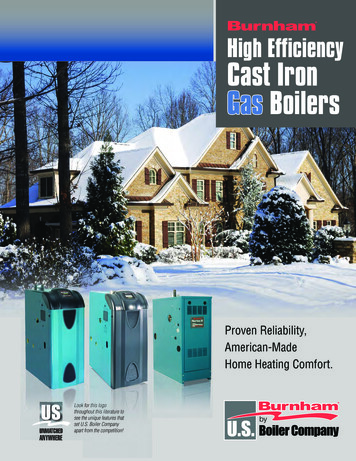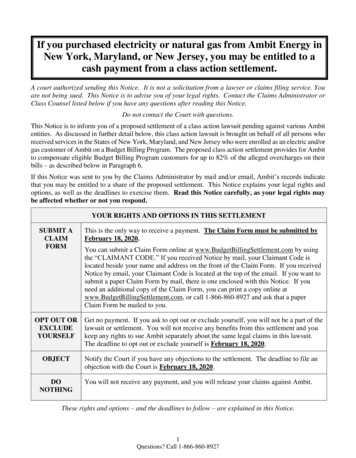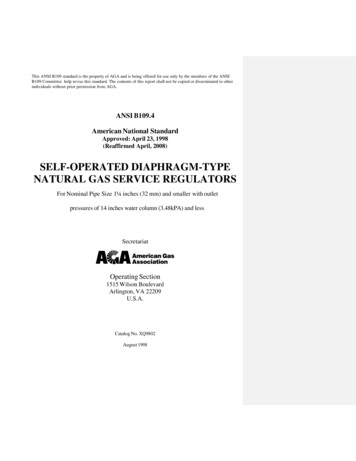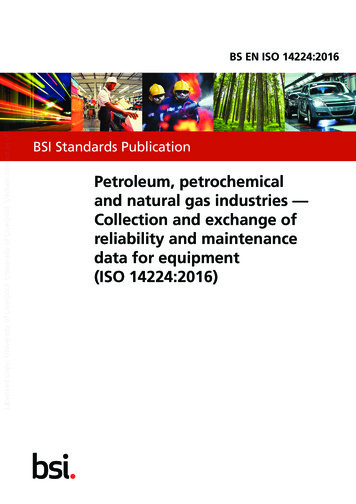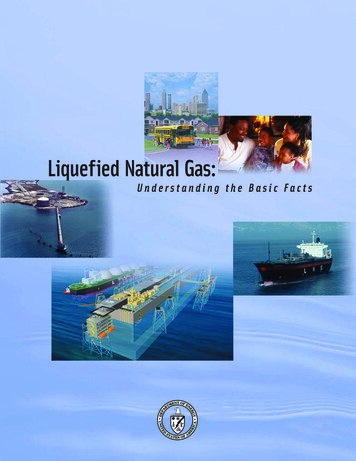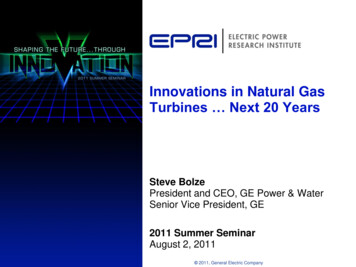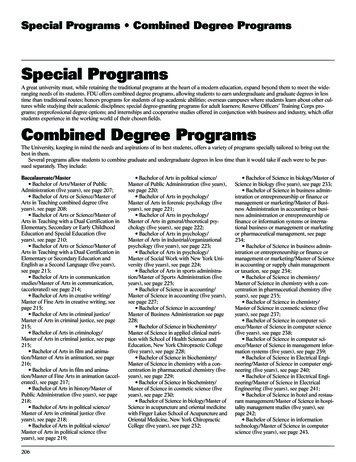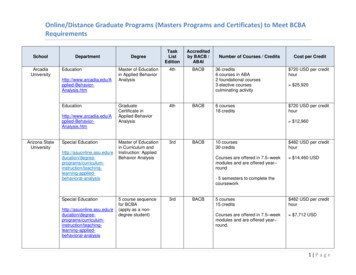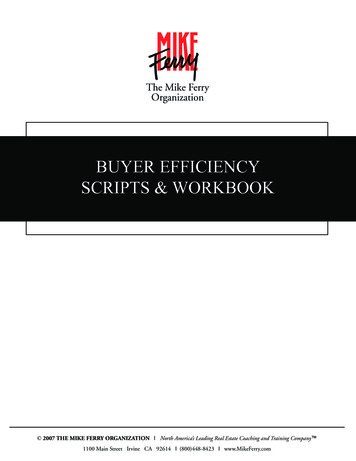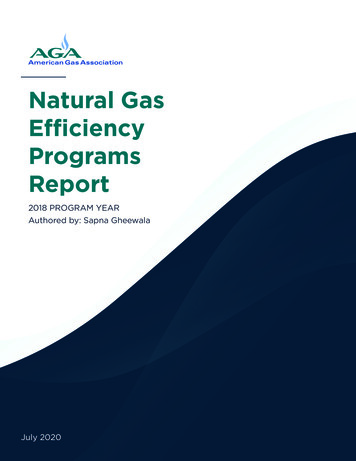
Transcription
Natural GasEfficiencyProgramsReport2018 PROGRAM YEARAuthored by: Sapna GheewalaJuly 2020
American Gas AssociationCopyright 2020 American Gas AssociationAll Rights ReservedPrepared by:Energy Analysis GroupAmerican Gas Association400 N. Capitol St., NW Washington, DC 20001www.aga.orgContact: Sapna Gheewala, sgheewala@aga.orgCopyright & Distribution: Copyright 2020 American Gas Association. All rightsreserved. This work may not be reproduced or transmitted in any form or by any means,electronic or mechanical, including photocopying, recording, or by information storageand retrieval system without permission in writing from the American Gas Association.Notice: In issuing and making this publication available, AGA is not undertaking torender professional or other services for or on behalf of any person or entity. Nor isAGA undertaking to perform any duty owed by any person or entity to someone else.Anyone using this document should rely on his or her own independent judgment or, asappropriate, seek the advice of a competent professional in determining the exercise ofreasonable care in any given circumstance. The statements in this publication are forgeneral information and represent an unaudited compilation of statistical informationthat could contain coding or processing errors. AGA makes no warranties—express orimplied—or representations about the accuracy of the information in the publication orits appropriateness for any given purpose or situation.This publication shall not be construed as including advice, guidance, orrecommendations to take or not to take any actions or decisions in relation to anymatter, including without limitation relating to investments or the purchase or sale ofany securities, shares, or other assets of any kind. Should you take any such actionor decisions, you do so at your own risk. Information on the topics covered by thispublication may be available from other sources, which the user may wish to consult foradditional views or information not covered by this publication.2020 Natural Gas Efficiency Programs Report — 2
American Gas AssociationTable of ContentsExecutive Summary4Introduction6Methodology and Survey Sample8Natural Gas Efficiency Program Characteristics9Program Structure and Administration10Customer Segments and Participants11Energy Efficiency Program Activities and Components12Greenhouse Gas or Carbon Emissions Targets and Credits14Natural Gas Efficiency Program Funding and Impacts15Natural Gas Efficiency Program Expenditures and Funding16Natural Gas Efficiency Program Savings18Natural Gas Efficiency Program Planning and Evaluation21EM&V Expenditures and Budgets21Tracking Greenhouse Gas Emission and Source Energyas a Measure22Natural Gas Efficiency Regulatory Requirements and CostRecovery Treatment23Natural Gas Efficiency Program Requirements andPolicy Goals24Rate Structures and Regulatory Treatment Aligned withUtility and Energy Efficiency Goals27Recovery of Energy Efficiency Costs28Direct Program Cost Recovery28Lost Margin Recovery30Utility Performance-Based Incentives33Fuel Switching35Conclusion372020 Natural Gas Efficiency Programs Report — 3
American Gas AssociationExecutive SummaryIn 2019 the American Gas Association (AGA) and the Consortium for EnergyEfficiency (CEE) surveyed their U.S. and Canadian members and efficiency programadministrators on the status of their 2018 ratepayer-funded natural gas efficiencyprograms, including expenditures, savings impacts, carbon dioxide emissionsreductions, and budgets for 2019. Based on survey findings for the 2018 program year:Natural Gas Efficiency ProgramFunding and ImpactsNatural Gas Efficiency ProgramCharacteristics In North America (U.S. and Canada),participating utilities spent 1.47 billion in2018 on natural gas efficiency programs - 1.41billion and 59 million in the U.S. and Canada,respectively. Participating utilities also budgetednearly another 1.4 billion for the 2019 programyear Natural gas utilities continue to help theircustomers to reduce energy usage andlower their annual energy bills by investingin successful and innovative efficiencyprograms, which include cash rebates andfinancial incentives, low-income specificprograms, strategic partnerships, jointprograms with other electric and gas utilities,efficiency loans, education campaigns,targeted marketing, energy audits, wholehouse projects, and customized retrofits oflarge facilities. Natural gas utilities in the U.S. spend 3.8 millionon energy efficiency programs every day. Program funding in North America increased bymore than eight percent from 2016 to 2018. Inthe United States, program funding has grownover 77 percent since 2007 and over 20 percentsince 2012. North American natural gas utilities saved425 million therms or 42.5 trillion Btu, theequivalence of 2.25 million metric tons ofavoided CO2 emissions in 2018. Natural gas utilities fund at least 132 activenatural gas utility ratepayer-funded efficiencyprograms in North America—125 programsin 42 states in the U.S. and seven programs inCanada. Natural Gas utilities helped customers save 259trillion Btu of energy and offset 13.7 millionmetric tons of carbon dioxide emissions from2012 through 2018 in the U.S. Natural gas utilities spent 365.34 million dollarson low-income efficiency programs and assistedover 214,581 low-income participants in 2018. Weatherization is the third most commoncomponent of natural gas efficiency programs—offered in 70 percent of low-income programs.2020 Natural Gas Efficiency Programs Report — 4
American Gas AssociationNatural Gas Efficiency RegulatoryRequirements and Cost RecoveryTreatment Many states mandate utility investment in naturalgas efficiency programs through a regulatory orderor legislation. Of the total 105 utilities in the 40states and 3 Canadian provinces that responded, 77utilities indicated that the state in which it operatesrequires the funding of an efficiency program. The top five goals driving efficiency programfunding requirements within the U.S. and Canadainclude energy conservation and savings, customerdollar savings or bill reduction programs, behavioralchange and direct outreach programs, reducedusage for low-income customers, and value-addedcustomer service and options programs. Seventyfive utilities in 35 states have set more than onegoal, of which 12 utilities are pursuing ten or moretargets.Natural Gas Efficiency ProgramPlanning and Evaluation North American spending on evaluation,measurement and verification activitiesexceeded 34 million in 2018. The 2018expenditures increased from 2017 by about13 percent each in North America and the U.S. About 1/3 of participating utilities indicatedthat a reduction of greenhouse gas orcarbon emissions is a performance targetfor their efficiency program. Additionally, 31utilities indicated that reducing greenhousegas emissions / direct impact on avoidedemissions as part of a state requirement by theprogram provider, 26 utilities indicated thatit was due to a regulator goal, and 21 utilitiesindicated that the goal was a policy target inenabling legislation. Thirty-seven states permit utilities to recovernatural gas efficiency program costs, 27 allowthem to recoup lost margins related to programimplementation, and 15 approve financialincentives to reward efficiency programimplementation or performance. Recovery of natural gas efficiency direct programcosts are allowed via the following mechanisms:– Special tariff or rider - 22 states– Base rates - 11 states– System benefits surcharge - 8 states– Deferral accounts - 7 states– Other mechanisms - 15 states Natural gas efficiency programs are found inall 42 states that allow the utility to segregatemargin recovery from its natural gas throughput ordelivered volumes. Twenty-one percent of respondents (19 of 92)reported that their regulator-approved naturalgas efficiency program encourages fuel switchingthrough financial incentives (e.g., rebates, loans,and other benefits) for customers who install naturalgas equipment in new homes, convert to natural gasfrom other fuels, or replace old equipment with newhigher-efficiency natural gas equipment.2020 Natural Gas Efficiency Programs Report — 5
American Gas AssociationIntroductionPublic awareness of the energy economyhas steadily grown beyond the purviewof business and policy. Economic,environmental, and energy securityconcerns have become increasinglyimportant drivers of consumer decisionsabout energy. With this has comeheightened attention to the potential forenergy efficiency to moderate consumercost increases, reduce greenhouse gasemissions, and enhance energy systemreliability and resilience. For natural gasutilities, investing in energy efficiencyprograms presents an opportunity toachieve these objectives and benefit thecommunities they serve. Many natural gasutilities across North America have longperforming natural gas efficiency programs.Increasingly, natural gas utilities working incollaboration with regulators are workingto create new or expanded programs thatwill accelerate progress towards realizinga clean energy future while buildingsustainable value of natural gas for theircustomers.The American Gas Association Natural GasEfficiency Programs Report - 2018 ProgramYear presents a review of ratepayer-fundednatural gas efficiency and conservationprograms in North America. The report looksretrospectively at the status of the NorthAmerican natural gas efficiency marketin 2018, including data on aggregatedexpenditures, savings impacts, carbondioxide emissions reductions, and budgetsfor 2019. It also explores regulatoryapproaches to advancing the natural gasefficiency market.This study portrays the extent of thisrapidly growing market in the UnitedStates and Canada and identifies practicesand trends in program planning, funding,administration, and Evaluation. The findingsillustrate how natural gas utilities haveworked with their customers to reducetheir greenhouse gas emissions footprint,increase cost savings, and improve deliveredenergy services.2020 Natural Gas Efficiency Programs Report — 6
American Gas AssociationThe data and findings presented in thisreport are based on a survey of naturalgas utility members of the American GasAssociation and the Consortium for EnergyEfficiency.1 The data collection effort hasexpanded significantly since AGA andCEE began coordinating efficiency datagathering in 2009. By joining efforts, AGAand CEE have reduced the reporting burdenfor respondents, eliminated duplicativeefforts, and significantly enlarged thesample pool by extending the survey to moreutilities in the U.S. and Canada and thirdparty administrators of ratepayer-fundedefficiency programs.to confirm ambiguous or incompleteresponses. Furthermore, this is a snapshotof a given point in time based on theinformation available at the time thesurvey was completed and may not reflectannual results.AGA would like to thank the members ofAGA and CEE in the U.S. and Canada forparticipating in this critical data-collectioneffort. It appreciates tremendouslythe time and effort given by all surveyrespondents throughout the informationgathering process, including extensiveclarification and data validation follow upThe report is based on survey responsesthat are not audited nor normalized andmay elicit different responses based onthe unique accounting and regulatorycircumstances of each company. However,multiple efforts are taken to confirm theaccuracy of responses throughout thedata collection and analysis timeframes1. An essential contributor to this data-gathering project is the Consortium for Energy Efficiency(CEE). CEE is an award-winning consortium of efficiency program administrators from theUnited States and Canada. Members work to unify program approaches across jurisdictionsto increase the success of efficiency in markets. By joining forces at CEE, individual electricand gas efficiency programs are able to partner not only with each other, but also with otherindustries, trade associations, and government agencies. Working together, administratorsleverage the effect of their ratepayer funding, exchange information on successful practicesand by doing so achieve greater energy efficiency for the public good.2020 Natural Gas Efficiency Programs Report — 7
American Gas AssociationMethodology andSurvey SampleIn 2019, the American Gas Association(AGA) and the Consortium for EnergyEfficiency (CEE) surveyed their respectiveU.S. and Canadian members on the status,characteristics, and metrics of their 2018ratepayer-funded natural gas efficiencyand low-income weatherization programs.2Respondents include utility and nonutility, or third-party, efficiency programadministrators.The sample frame consists of 132 memberand nonmember organizations identifiedas large program administrators of AGAand CEE. The survey asked respondentsto describe their natural gas efficiencyprograms, including program expendituresand energy savings, during the 2018calendar year or coinciding program year forwhich data were available. Also, the surveyscollected data on 2019 program budgets.In this report, the term “natural gasefficiency program” refers to a set ofactivities designed to promote a costeffective and prudent approach to energyusage, including low-income single andmulti-family home weatherization, indirectimpact activities (such as conservationeducation, energy audits, and contractorcertification), and direct impact activitiesin new and existing buildings and homes(e.g., equipment replacement and EnergyStar Homes).Not all responding parties answered everysurvey question. Therefore, the responsesample varies by item. Because the samplepool is not normalized and varies year toyear, this report does not directly compare2018 with prior years data, except forillustrative purposes. Tables and chartsgenerally represent a simple tally of theresponses to the survey questionnaire.2. Because a number of low-income wea
2020 Natural Gas Efficiency Programs Report — 8 Methodology and Survey Sample In 2019, the American Gas Association (AGA) and the Consortium for Energy Efficiency (CEE) surveyed their respective U.S. and Canadian members on the status, characteristics, and metrics of their 2018 ratepayer-funded natural gas efficiency
